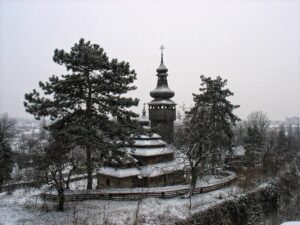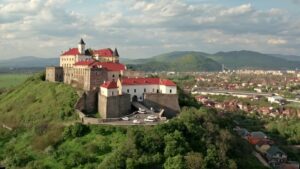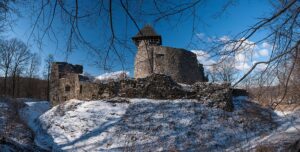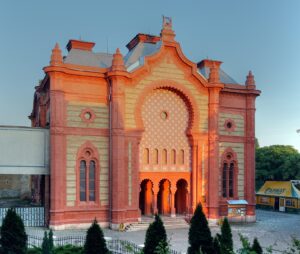Zakarpattia Oblast (Ukrainian and Rusyn: Закарпатська область) is an oblast in western Ukraine, mostly coterminous with the historical region of Carpathian Ruthenia or Transcarpathia, consisting mostly of mountains which cover about 80% of the oblast’s area, and cross from North-West to South-East. Zakarpattia is the only Ukrainian oblast to have boundaries with four countries: Poland, Slovakia, Hungary and Romania. The oblast’s administrative centre is located in the city of Uzhhorod.
The current population is 1,244,476 (2022 est.) with a mean age of 35 years. This total includes people of many different nationalities of which Hungarians, Romanians, and Rusyns constitute significant minorities in some of the province’s cities, while in others, they form the majority of the population. Those who recognize Ukrainian as their native language total 81.0% of the population; Hungarian — 12.7%; Russian — 2.9%; Romanian — 2.6%; and Rusyn — 0.5%.
Zakarpattia is home to approximately 14,000 ethnic Roma (Gypsies), the highest proportion of Roma in any oblast in Ukraine. Beside the major ethnic groups, Zakarpattia is home to several ethnic sub-groups such as Boykos, Lemky, Hutsuls, and others.
The Carpathians are an important tourist and travel destination housing many ski and spa resorts, meaning that they play a major part in the oblast’s economy. A high altitude lake called Nesamovyte is located in Rakhiv Raion, in the Hoverla preserve on the slopes of Turkul mountain.
The Primeval Beech Forests of the Carpathians, part of which are located within Zakarpattia Oblast, were recognized as a UNESCO World Heritage Site in 2007. Four of the oblast’s historical-cultural sites were nominated for the Seven Wonders of Ukraine competition in 2007: Palanok Castle, Museum upon the Chorna River, Mykhailiv Orthodox Church, and the Nevytsky Castle.
 Museum of Folk Architecture and Life – Uzhhorod is an open-air museum located in Uzhhorod, Ukraine. It features over 30 traditional structures collected from villages across Zakarpattia Oblast, the Ukrainian province of which Uzhgorod is the capital. According to Michael Benanav of The New York Times, “the museum’s centerpiece is 16th-century St. Michael’s Church, with a roof and onion-domed steeple covered in wooden shingles.”
Museum of Folk Architecture and Life – Uzhhorod is an open-air museum located in Uzhhorod, Ukraine. It features over 30 traditional structures collected from villages across Zakarpattia Oblast, the Ukrainian province of which Uzhgorod is the capital. According to Michael Benanav of The New York Times, “the museum’s centerpiece is 16th-century St. Michael’s Church, with a roof and onion-domed steeple covered in wooden shingles.”
 Palanok Castle. The Palanok Castle or Mukachevo Castle (Ukrainian: Замок “Паланок”) is an historic castle in the city of Mukacheve in the western Ukrainian oblast (province) of Zakarpattia. Archaeological research shows that the area was already inhabited in the Neolithic era, and that in the Bronze and Iron Ages there was a fortress on the site of today’s castle.
Palanok Castle. The Palanok Castle or Mukachevo Castle (Ukrainian: Замок “Паланок”) is an historic castle in the city of Mukacheve in the western Ukrainian oblast (province) of Zakarpattia. Archaeological research shows that the area was already inhabited in the Neolithic era, and that in the Bronze and Iron Ages there was a fortress on the site of today’s castle.
One legend has it that the name of the city and its castle – Munkács – an Hungarian term for “worker” – relates to how hard it was to traverse the mountainous area to just access the stronghold. According to another narrative, the name of the castle and the city stems from the Slavic word for “suffering”, because the construction of the castle and the application of the stone works to it required intense labor and suffering. The name Palanok comes from an oak fence that once surrounded the castle moat.
During modern times the castle became an Austrian prison, and during the Soviet era a military barracks. Today, the restored castle features a museum of local lore and an art gallery, with plans for a proposed tourist center and hotel.
 Nevytske Castle (Ukrainian: Невицький замок; Hungarian: Nevickei vár) is a semi-ruined castle in Zakarpattia Oblast, Ukraine. The castle was first mentioned in 1274 belonging to the King of Hungary Laszlo IV as a dungeon or a keep. Completely rebuilt in the early 15th century, it towered over the Uzh River and was a mighty citadel of the Drugeth family which supervised its continuous modernisation over the centuries.
Nevytske Castle (Ukrainian: Невицький замок; Hungarian: Nevickei vár) is a semi-ruined castle in Zakarpattia Oblast, Ukraine. The castle was first mentioned in 1274 belonging to the King of Hungary Laszlo IV as a dungeon or a keep. Completely rebuilt in the early 15th century, it towered over the Uzh River and was a mighty citadel of the Drugeth family which supervised its continuous modernisation over the centuries.
The keep, rebuilt in its present form in the early 16th century, passed from hand to hand during the internecine strife that convulsed Hungary in the early 17th century. By the end of the 19th century the ruins of the castle were abandoned. In 1923, the castle was handed over to the Uzhhorod tourist club, who installed a protective roof on the towers. In the 1960s and 1970s, additional work was carried out on the conservation and restoration of the castle.

Uzhhorod Synagogue. The synagogue was completed and dedicated on July 27, 1904, then located within the Austro-Hungarian Empire. The building was designed by the architects Gyula Papp and Ferenc Szabolcs, in a flamboyant Romantic style that boldly intermingled Byzantine Revival and Moorish Revival architectural elements.
Since World War II the building has served as Uzhhorod’s concert hall, prized for its acoustics. It has housed the Regional Philharmonic Society with the Transcarpathian Folk Choir.
All Jewish symbols were removed from the building, although as of 2012 there is a plaque on the facade commemorating the 85,000 Jews from Zakarpattia Oblast who were murdered in The Holocaust. There are now plans to restore the glass dome with its mosaics.
If you’ve got any questions, please do not hesitate to call, text or email us. We’re here to help you.
+380 (50) 242 75 54
dborysenko@gmail.com
ancestry@ukrainian-ancestry.com